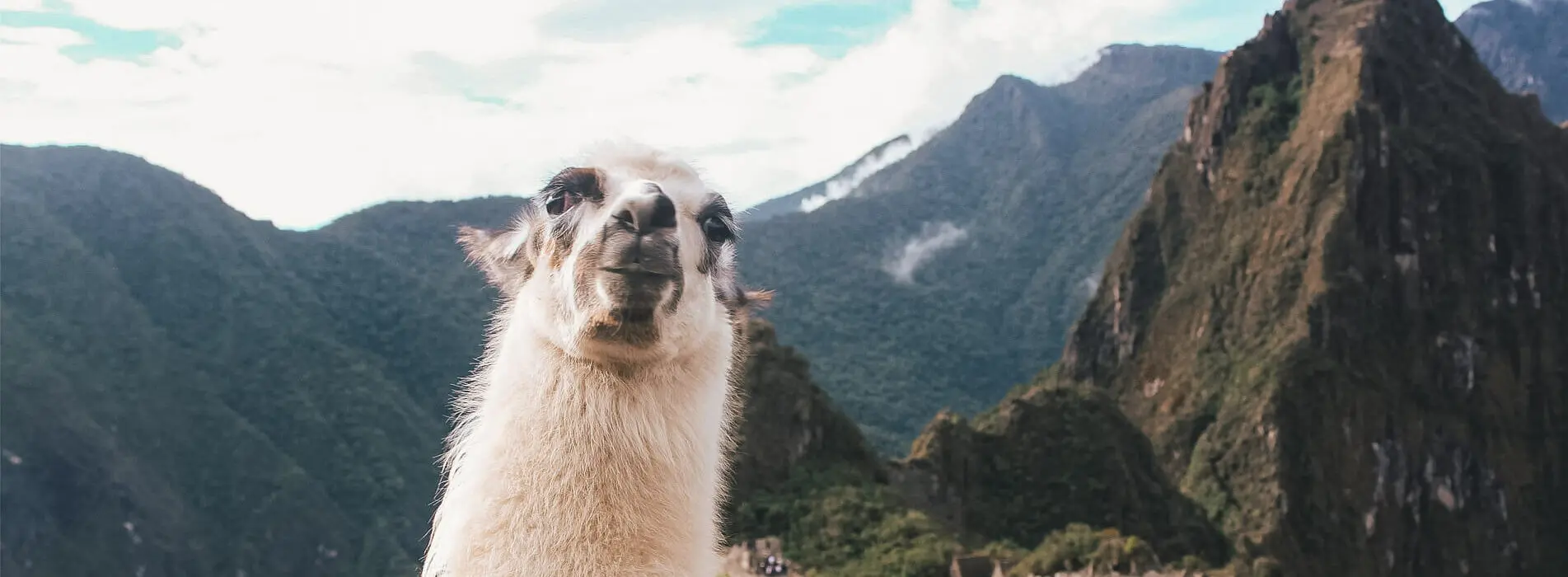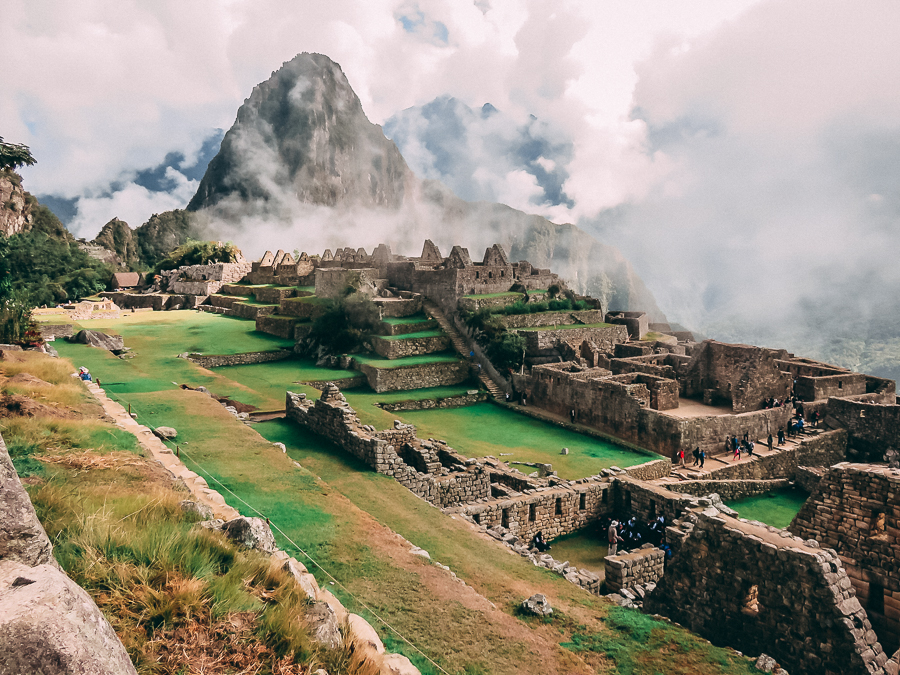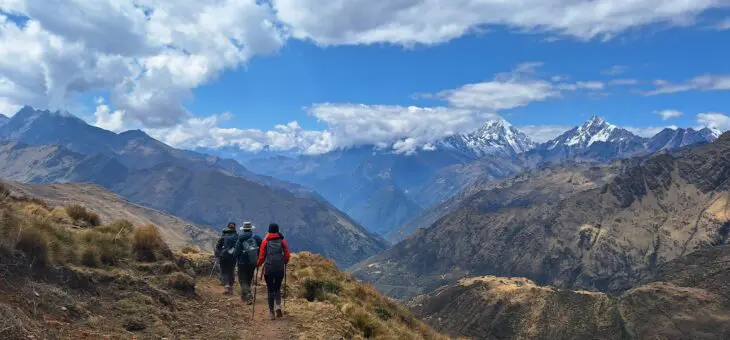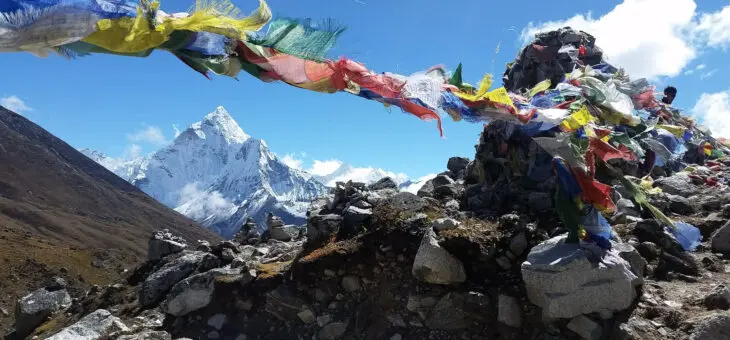This guide to the Flora and Fauna of Machu Picchu was written by Eileen Farrell who came to Machu Picchu with us in October 2018. Eileen’s background is in Fine Art Painting and Textiles. She was a knitwear designer for 16 years before becoming an Irish Tour guide. She’s an avid Hill Walker and has gardened for more than 40 years in Ireland. She loves both drawing and photographing plants especially in the wild.
Note: We have extended our Machu Picchu Trek to 10 days to take in the ancient city of Choquequirao. The flora and fauna described in this article will also be visible on our new itinerary. You can see the changes to our Machu Picchu Trip here.
Slow time
There are many reasons for trekking in mountains and one of the most wonderful is SLOW TIME. The most amazing part of ‘slow time’ is what there is to discover right in front of you. I faced the Machu Picchu trek with Earth’s Edge not simply to get to the World Heritage site but also for the challenge of getting there. I knew we would have long days of walking at altitude, sleeping in a tent under southern hemisphere skies and carrying a backpack, but it’s all part of that “slow time”. There would be the awe of the Andes, but just as ‘awesome’ was what we would see at eye level and underfoot, the amazing plants, flowers, birds, and animals that thrive high altitudes.
As a gardener in Ireland, I am always interested in finding wild forms of plants to cultivate in my garden. Each plant has its origin in the wild, brought home by an adventurous botanist to study and cultivate in his or her garden. Anyone who has driven on the Dingle peninsula and marvelled at the glowing hedgerows of Fuchsia should be excited by a trek to Machu Picchu because these plants are also found in the cloud forests of Peru. They were named after German botanist Dr Fuchs, and you can still see them growing wild in their native habitat.
High Altitude Start
To get to the start of our trek was an adventure in itself. All 20 of us climbed into a minibus and drove from Cusco which is at 3,350m, to meet the men who would take our camping gear, all our food, tents and extra equipment on their sturdy Andean ponies. As we bumped along the unpaved mountain roads, our first viewing of the wildflowers of Peru was at about 30mph. “Look, Ceanothus with bromeliads growing in their branches!” There are no bromeliads in my garden; you would have to go to the National Botanical Gardens in Dublin to see these growing in the glasshouses but yes, cerulean blue Ceanothus are in the gardens of Ireland. We hadn’t even started walking but already I was giddy and there were scarlet blooming Rhododendron and the white flowering Viburnum just growing by the roadside.
Our trek started in October spring sunshine with everyone in extremely high spirits. We knew that the pace must be kept slow as the air is thin at 3,600m, and only gets thinner as we reach camp at about 4,400m, after about 5 hours of trekking. Eyes down and already the sides of the trail are awash in tiny flowering pink Erodium, commonly called ‘stork’s bill’ and nearby the high altitude varieties of the dogwood Cornus grew. There were many grey-green tiny leafed plants making cushiony mats amongst the miniature ferns and mosses. All difficult to identify! As we trekked, our eyes would catch the movement of birds flitting amongst the mountain scrub like the Golden-billed Saltator, the Peruvian Sierra Finch and the Andean Flicker, a terrestrial woodpecker.
First Camp and Day 2 trekking
We arrived at first camp cold and wet at 4,480m but found our tents up and the cooks busy with dinner. All we really wanted to do was sleep! We were given an hour to rest. We crawled into our tents under a dark stormy sky and awoke an hour later to starlight with the Milky Way right above us, bright enough to read by. It was one of the wonders of the Andes that I was hoping to experience and it didn’t disappoint. We wolfed down a hot dinner and I slept like a stone on the mountain.
We had an early start next morning with a sustaining hot breakfast at 6 am and a surprise of blue corn pancakes. Everyone was digging in when our Peruvian guides, Edgar and Victor, came in to say there were chinchillas behind the food tent. Down tools and fly! Cameras out! What did these hardy mountain rodents look like in the wild and what were they up to? It turns out they were helping themselves to the fruit and veg peeling left out for the ponies. These particular critters turned out to be Viscachas, in the Chinchillidae family.
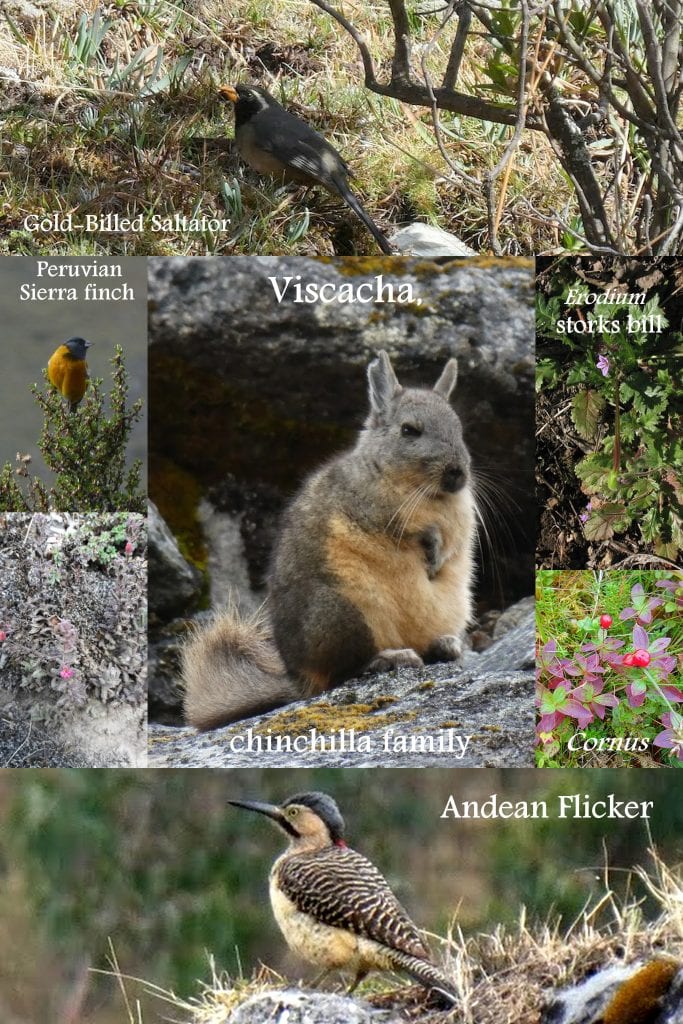
We soon set off to negotiate the highest part of the trek, a 4,630m pass followed by a steep descent into a cloud forest valley. This is where both the flora and the clouds were hanging at eye level. It was very slow walking as the trail was steep and rocky. The first of the many Fuchsia species that are abundant here was an orange trumpet called Fuchsia alpestra. We learned that the locals call it Lady’s Eardrops. On the steep side of the path, we found a rose pink variety of Passionflower, Passiflora pinnatistipula, commonly called ‘Poro Poro’. I grow the Blue Passionflower on a south wall in Ireland; this mountain variety looked completely different!
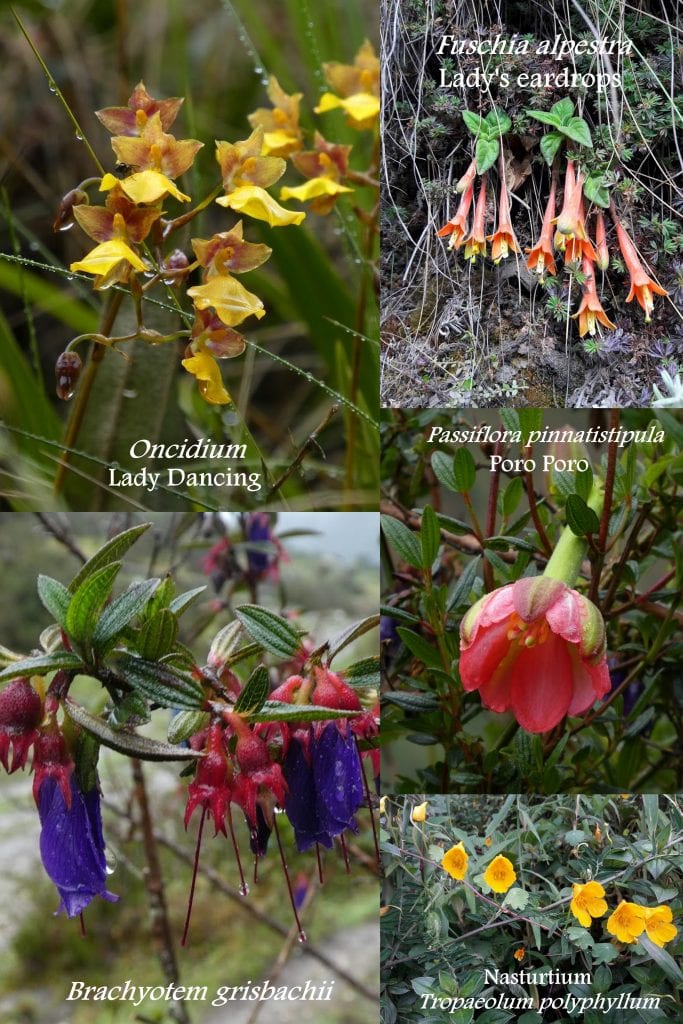
A short way along, I spotted a deep indigo flowering plant that I had never seen before called Brachyotum grisebachii that has no common name. While navigating some steps built into the trail there was a lovely yellow wild form of nasturtium called Tropaeolum polyphyllum and right above that, I got my first sighting of a wild Peruvian orchid Oncidium. It was covered in mist and spider silk and locally it’s called “Dancing Lady”. You only have to look at it to know why the locals call her that! As we descended and the clouds got thicker we found even more tantalizing native flowers with no common names, plants I’d never heard of like Vochysia peruviana with yellow cone-shaped flowers and the pink flowering Oreocallis grandiflora and the deep red Bomarea.
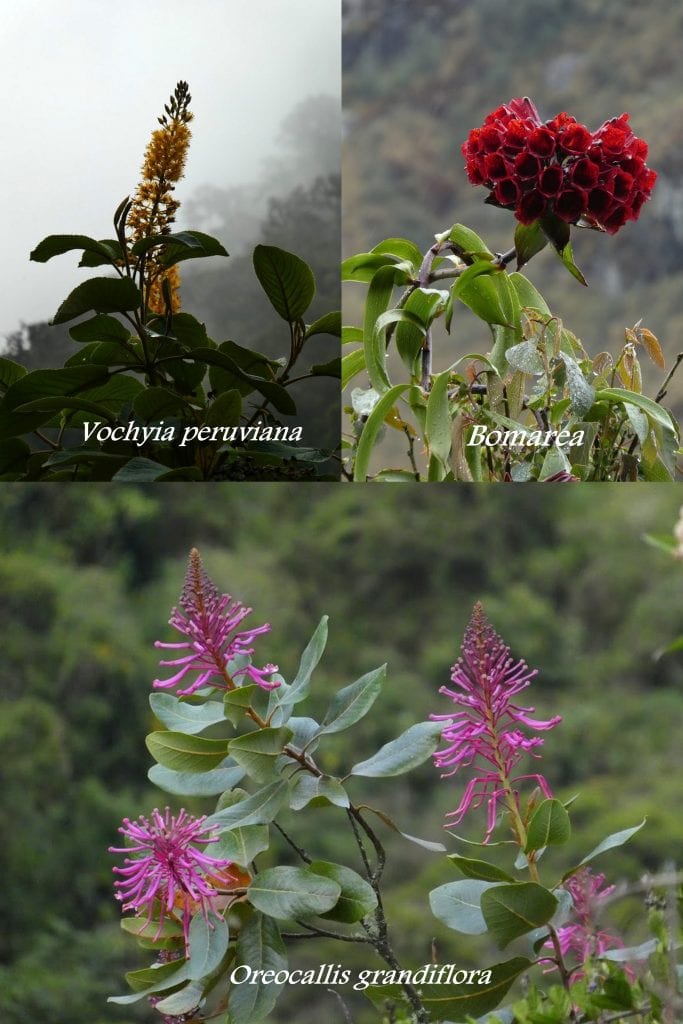
Second camp and Day 3 trekking
Our second day of trekking was long and some of us didn’t get into camp until dark, wearing our headlamps and ready for food! We camped in a farmer’s yard and the roosters woke us the next day at 5 am! Breakfast was freshly laid eggs scrambled to perfection so we all set off satisfied. We started hiking down a dirt road that ran parallel to a deep ravine with jungle on both sides. Flocks of parakeets screeched overhead and deep magenta bamboo orchids Sobralia dichotoma swayed in the morning breeze. The mountain side of the path had the beautiful pink orchid Epidendron secundum locally called Winay Wayna or “live forever” and the lemon yellow Calceolaria commonly called “baby’s slippers” used to dress graves in Peru.
We soon approached a stream crossing our dirt road but noticed that the ground quivered. It was covered with butterflies sipping minerals from the mud! There were red & black ones Atinote negra, ones with translucent wings Chorinea sylphina, the Angle and the Orange-spot Duke Siseme neurodes. We all have heard that Walter Raleigh returned from Peru with tobacco, so I was also delighted to see the wild tobacco Nicotiana tomentosa growing nearby. This day was a much easier hike because we were dropping in altitude and spent the afternoon at a small coffee plantation for lunch also learning about how coffee grows and how it is roasted.
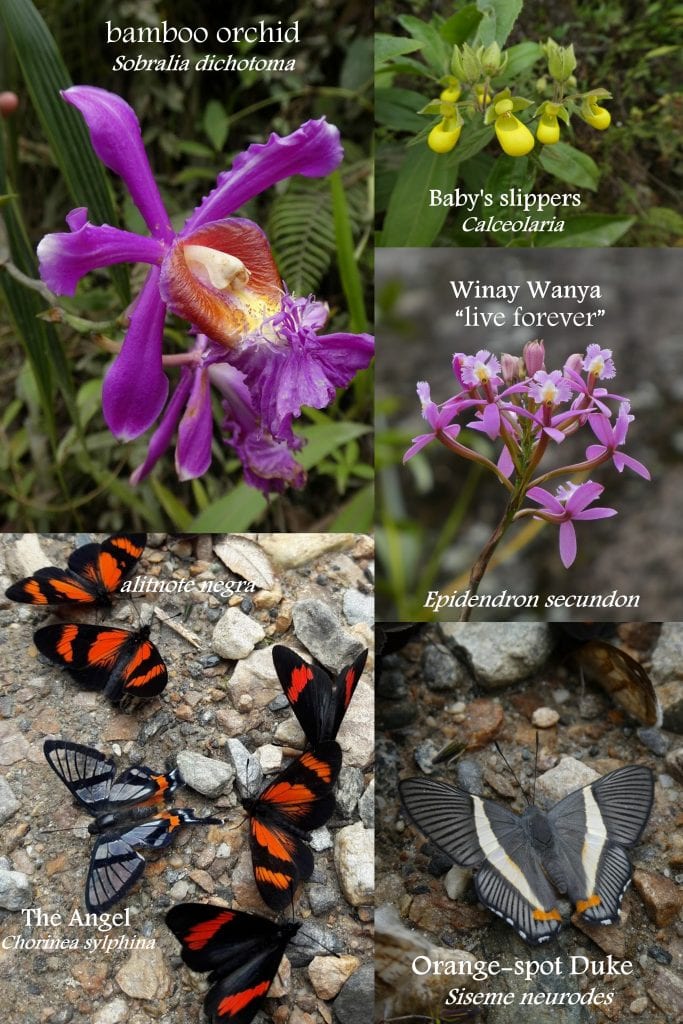
Third camp and the walk to Aguas Caliente and finally to Machu Picchu
The next morning, after having hummingbirds delight us during breakfast, almost impossible to photograph, we walked along the train tracks to Aguas Calientes. We were now among thick vines and the jungle was vibrant with bird calls. Bright flashes of turquoise as the Blue-necked Tanager and the Andean Motmot darted through the vegetation. Probably the best sighting of all was the national bird of Peru, the Andean Cock-of-the-rock Rupicola peruvianus with its fiery red neck feathers and beady eyes. This trail was thick with purple vines of Cobea, the cup & saucer plant and Heliconia subulata, better known to us as Bird of Paradise.
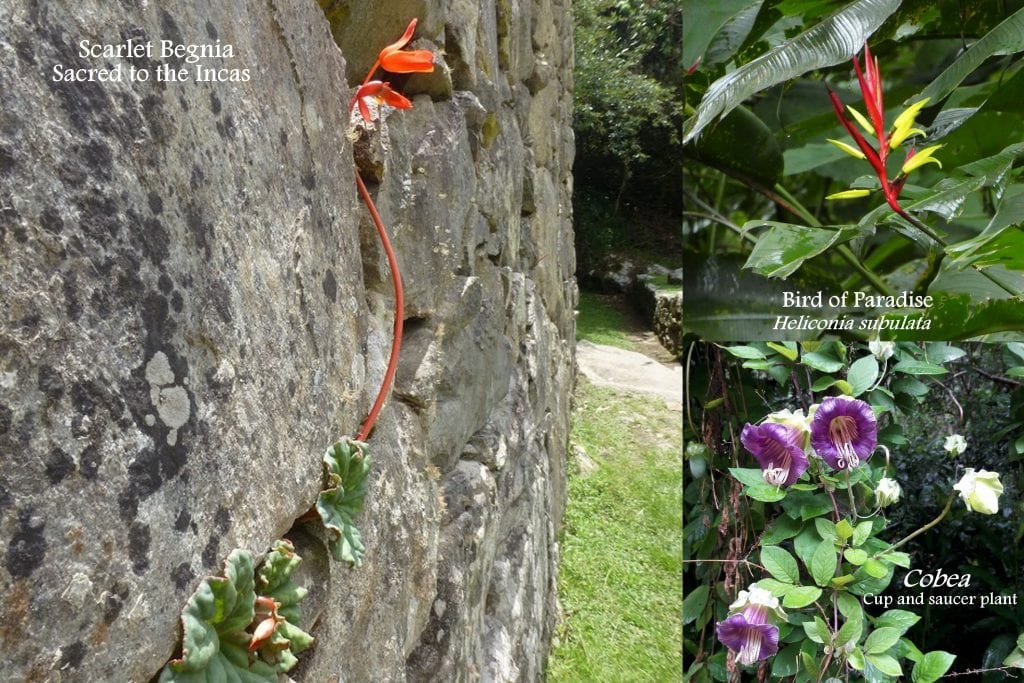
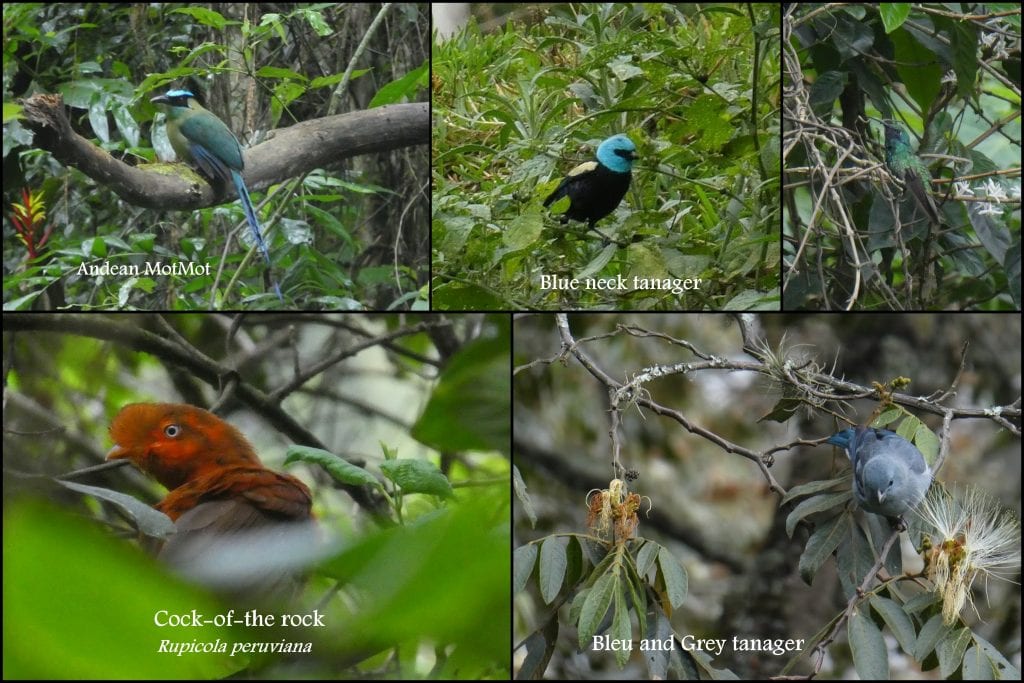
The next day was our ascent to Machu Picchu itself. It is as stunning and awe-inspiring as advertised! We arrived at 6 am to bright blue skies with hawks circling overhead. Whatever you expect, Machu Picchu simply offers up itself. After days of stunning flora, it was surprising that only one flower was allowed to interrupt the beautiful masonry of the ancient buildings, the Scarlet Begonia, which was sacred to the Incas. Low clouds arrived in the afternoon and rain looked imminent but never reached the ground as the steep sides of the surrounding mountains held it at bay. As the day wore on and the sun slanted we had the great good luck to see a rainbow arching over the surrounding mountains. The monument is kept in perfect trim by a small resident herd of llama cropping the terraced lawns from opening to closing time. As our time to leave drew near, one last image remains. Llama relaxing! The caretakers work done, everyone needs a break every now and then! Finally, we had one last evening in Aguas Caliente to reflect upon it all.
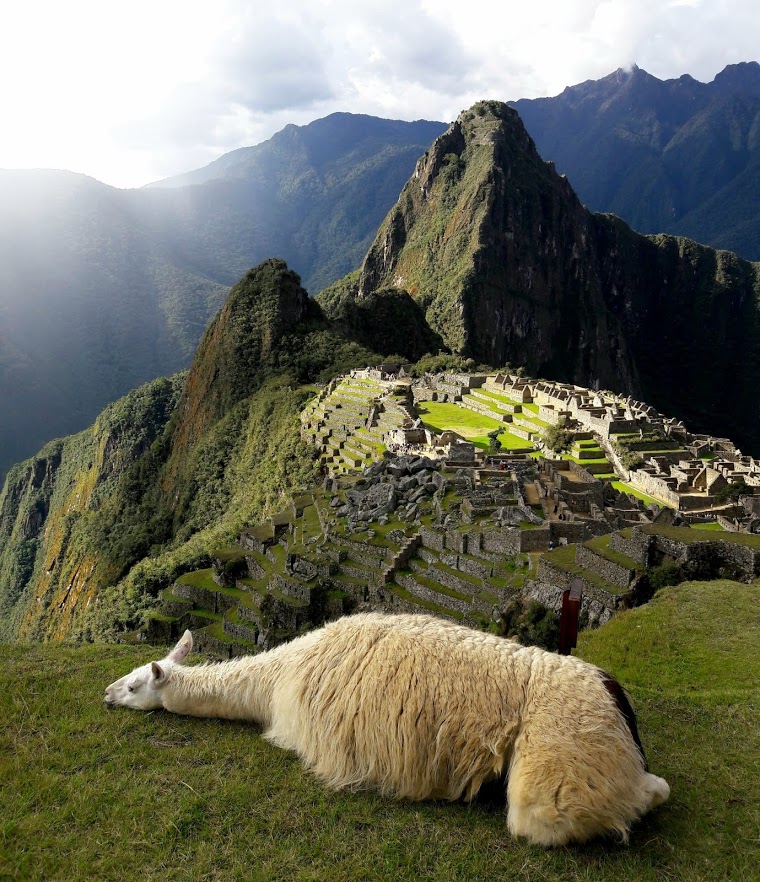
To have your own experience with the flora and fauna of Machu Picchu you can find more information and book your trip on our Machu Picchu Expedition page.
